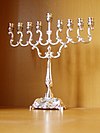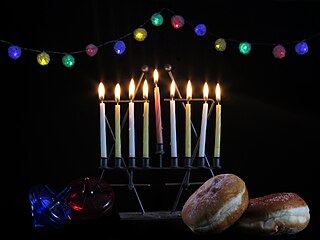
Hanukkah is a Jewish festival commemorating the recovery of Jerusalem and subsequent rededication of the Second Temple at the beginning of the Maccabean Revolt against the Seleucid Empire in the 2nd century BCE.

The menorah is a seven-branched candelabrum that is described in the Hebrew Bible and in later ancient sources as having been used in the Tabernacle and in the Temple in Jerusalem. Into prehistory, its iconography can be traced to representations of the sacred tree. Since ancient times, it has served as a symbol representing the Jewish people and Judaism in both the Land of Israel and the Diaspora. It eventually became the State of Israel's official emblem after its founding in 1948.
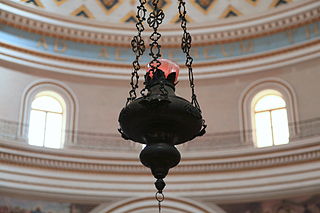
A sanctuary lamp, chancel lamp, altar lamp, everlasting light, or eternal flame is a light that shines before the altar of sanctuaries in many Jewish and Christian places of worship. Prescribed in Exodus 27:20-21 of the Torah, this icon has taken on different meanings in each of the religions that have adopted it. The passage, which refers to prescriptions for the tabernacle, states:
And thou shalt command the children of Israel, that they bring thee pure oil olive beaten for the light, to cause the lamp to burn always. In the tabernacle of the congregation without the veil, which is before the testimony, Aaron and his sons shall order it from evening to morning before the LORD: it shall be a statute for ever unto their generations on the behalf of the children of Israel. (KJV)
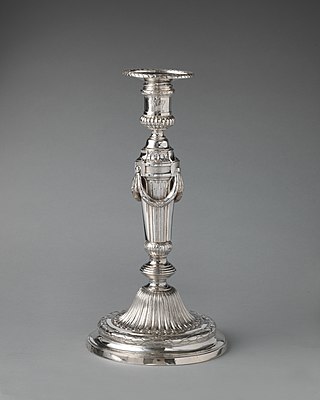
A candlestick is a device used to hold a candle in place. Candlesticks have a cup or a spike ("pricket") or both to keep the candle in place. Candlesticks are sometimes called "candleholders".

Sufganiyah is a round jelly doughnut eaten in Israel and around the world on the Jewish festival of Hanukkah. The doughnut is deep-fried, injected with jam or custard, and then topped with powdered sugar. The doughnut recipe originated in Europe in the 16th century, and by the 19th century was known as a Berliner in Germany. Polish Jews, who called it a ponchik, fried the doughnut in schmaltz rather than lard due to kashrut laws. The ponchik was brought to Israel by Polish Jewish immigrants, where it was renamed the sufganiyah based on the Talmud's description of a "spongy dough".
Hanukkah music contains several songs associated with the festival of Hanukkah.

Hanukkah gelt, also known as gelt, refers to money given as presents during the Jewish festival of Hanukkah. It is typically given to children and sometimes teachers, often in conjunction with the game of Dreidel. In the 20th century, candy manufacturers started selling Hanukkah-themed chocolate coins wrapped in gold or silver foil, as a substitute or supplement to real money gifts.
Oh Chanukah is an English version of the Yiddish Oy Chanukah. The English words, while not a translation, are roughly based on the Yiddish. "Oy Chanukah" is a traditional Yiddish Chanukah song. "Oh Chanukah" is a very popular modern English Chanukah song. This upbeat playful children's song has lines about dancing the Horah, playing with dreidels, eating latkes, lighting the candles, and singing happy songs. The song was written by Mordkhe (Mark) Rivesman, and first published in Susman Kiselgof's 1912 Lider-Zamlbukh [Song anthology].
A Hanukkah stamp is a holiday stamp issued to commemorate Hanukkah. Since 1996, several Hanukkah-themed postage stamps have been issued, often jointly.

Jewish ceremonial art, also known as Judaica, refers to an array of objects used by Jews for ritual purposes. Because enhancing a mitzvah by performing it with an especially beautiful object is considered a praiseworthy way of honoring God's commandments, Judaism has a long tradition of commissioning ritual objects from craftsmen and artists.

A public menorah is a large menorah displayed publicly during the Jewish holiday of Hanukkah. It is done to celebrate the holiday and publicize the miracle of Hanukkah, and is typically accompanied by a public event during one of the nights of Hanukkah attended by invited dignitaries who are honored with lighting the menorah.

The White House Hanukkah Party is an annual reception held at the White House and hosted by the U.S. President and First Lady to recognize and celebrate the Jewish festival of Hanukkah. The tradition was established in 2001, during the administration of George W. Bush. The guest list includes hundreds of American Jewish politicians, organization heads, and school and yeshiva deans.

A Hanukkah bush is a bush or tree—real or simulated—that some Jewish families in North America display in their homes for the duration of Hanukkah. It may, for all intents and purposes, be a Christmas tree with Jewish-themed ornaments. It is associated with Chrismukkah.

The National Menorah is a large Hanukkah menorah located in the northeast quadrant of The Ellipse near the White House in Washington, D.C. It was first lit in 1979 by President Jimmy Carter, and has been erected and lit every year since. The Menorah has grown in size as well, and is now 30 feet (9.1 m) high.
Thanksgivukkah is a holiday name portmanteau neologism given to the convergence of the American holiday of Thanksgiving and the first day of the Jewish holiday of Hanukkah on Thursday, November 28, 2013. It was the result of a rare coincidence between the lunisolar Hebrew calendar and the Gregorian calendar. Because the calendars are not calculated the same way, Hanukkah appears from year to year on different dates on the Gregorian calendar, ranging from late November to early January.

Miracle of the cruse of oil, or the Miracle of Hanukkah, is an Aggadah depicted in the Babylonian Talmud as one of the reasons for Hanukkah. In the story, the miracle occurred after the liberation of the Temple in Jerusalem during the Maccabean Revolt, and it describes the finding of a jug of pure oil that was to be enough to light the lamp for one day, but that lasted for eight days.
A Hanukkah film is a genre of film in which the main emphasis is on the celebration of the Jewish holiday of Hanukkah. Films in this style traditionally incorporate the religious aspects of Hanukkah, such as lighting the menorah and the story of the Maccabees, as well as the cultural aspects of Hanukkah, such as spinning dreidels, or eating traditional foods such as latkes, sufganiyot, or gelt. Films in this genre are typically similar to comedy and romantic comedy films in content, however some are similar in style to action, drama, and animated films, among other genres. Hanukkah films are more commonly produced in the United States, however, they are also produced in other countries such as Israel.

Six13 is a New York–based Jewish all-male a cappella singing group. Formed in 2003, the six-voice group is known for parodying contemporary pop songs by adding Jewish themes and lyrics. It also sings cover versions of pop hits and Yiddish and Israeli classics, and produces original compositions based on traditional Jewish prayers. Relying solely on vocals, the group achieves the effects of guitar, bass, drums, and electronic music through beatboxing and multiple layering of vocal tracks on its music videos. The group performs regularly for universities, synagogues, public and private groups, and in music festivals. It has released eight albums and won numerous awards.
Rosh Chodesh L'Banot, also known as Chag HaBanot, and in Arabic as Eid al-Banat, is a holiday celebrated by some Jewish communities in the Middle East on Rosh Chodesh of the Jewish month of Tevet, during the Jewish holiday of Chanukah. The Jewish community where the holiday was most preserved is in Tunisia. But there is also evidence that it was also celebrated in Jewish communities in Libya, Algeria, Kushta, Istanbul, Morocco and Thessaloniki.
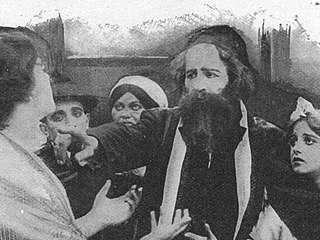
Throughout the history of Christianity, Jewish peoples have been historically religious minorities in countries that were majority or even officially Christian. Over time, a unique relationship evolved between the Jews and the major Christian holiday of Christmas, including the creation of separate traditions and the intersection of Hanukkah and Christmas, among other convergences. Some practices perpetuate out of a feeling of otherness, while others are merely lighthearted activities that are accessible when shops are closed around Christmastime.
























